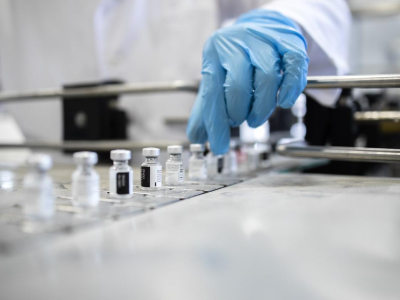The results of a randomized clinical trial conducted in the United Kingdom indicate that gentamicin is not a suitable alternative for ceftriaxone as part of first-line treatment for gonorrhea.
But gentamicin combined with azithromycin might be appropriate for treating genital gonorrhea or patients who are allergic to ceftriaxone or have a ceftriaxone-resistant infection, a team of British investigators reported in The Lancet.
The results also call into question the continuing use of azithromycin as part of the dual-therapy regimen.
Alternatives for ceftriaxone needed
The Gentamicin in the Treatment of Gonorrhea (G-ToG) trial was conducted as part of an effort to find an acceptable alternative to ceftriaxone, which is the current recommended treatment for gonorrhea infections. Both the US Centers for Disease Control and Prevention and the World Health Organization recommend the combination therapy of intramuscular ceftriaxone and oral azithromycin.
An alternative is needed because Neisseria gonorrhoeae—which is known for its ability to develop resistance quickly and has cycled through several antibiotics—is becoming increasingly resistant to ceftriaxone. Azithromycin, which has a different mechanism of action than ceftriaxone, was added to the regimen to improve treatment efficacy and to slow the emergence of ceftriaxone resistance.
While three new antibiotics—zoliflodacin, solithromycin, and gepotidacin—are currently being investigated in phase 2 and 3 trials for treating gonorrhea, gentamicin has also been considered as an option. In vitro studies of the decades-old antibiotic have found that N gonorrhoeae isolates remain susceptible to it, but data on its efficacy in treating patients with gonorrhea infections is limited.
In the multicenter non-inferiority trial, conducted at 14 sexual health clinics in England, the investigators enrolled 720 teens and adults aged 16 to 70 years old with uncomplicated genital, pharyngeal, or rectal gonorrhea. Participants were randomly assigned 1:1 to receive a single intramuscular dose of either 240-milligrams (mg) gentamicin or 500-mg ceftriaxone, with both groups also receiving a single oral dose of 1 gram (g) of azithromycin. The primary outcome was clearance of N gonorrhoeae at all sites. The non-inferiority margin was 5 percentage points.
After 2 weeks of treatment, the infection was cleared in 299 (98%) of the 306 patients in the ceftriaxone arm, compared with 267 (91%) of 292 patients in the gentamicin group, for an adjusted risk difference of −6.4 percentage points (95% confidence interval [CI], −10.4 to −2.4), indicating inferiority.
While the cure rate for genital infections was within the non-inferiority margin (98% in the ceftriaxone group vs 94% in the gentamicin group; adjusted risk difference (ARD), –4.4 percentage points; 95% CI, − 8.7 to 0.0), gentamicin was significantly inferior to ceftriaxone in clearing pharyngeal infections (96% vs 82%; ARD, 15.3 percentage points; 95% CI, −24 to −6.5) and rectal infections (98% vs 90%/ ARD −7.8 percentage points; 95% CI, −13.6 to −2.0).
"Gentamicin cannot therefore be recommended to replace ceftriaxone as first-line therapy for gonorrhoea," the authors of the study write. "However, gentamicin combined with 1 g azithromycin achieved a cure rate of 94% for genital gonorrhoea, and its use might be appropriate in patients who are allergic, intolerant, or harbour a ceftriaxone-resistant infection."
The number of adverse effects was similar between the two groups, with both drugs being well tolerated, but participants who received a shot of gentamicin reported more severe pain at the injection site than those who receive a shot of gentamicin.
Questions about combination therapy
The investigators also found that the oral dose of azithromycin did not prevent treatment failure in the participants who received gentamycin. Of 16 cases of treatment failure, 11 occurred in patients with isolates that were susceptible to azithromycin; of the other five patients, two had azithromycin-resistant isolates and three had isolates with intermediate azithromycin susceptibility.
"A 1 g dose of azithromycin as a component of dual therapy for gonorrhoea had limited efficacy in treating gentamicin-resistant infections and this suggests that its widespread use to prevent development of resistance requires review," they write.
This finding from the trial was among the reasons cited by the British Association for Sexual Health and HIV in its decision to drop the recommendation for dual therapy with azithromycin in patients with uncomplicated gonorrhea in its 2019 guidelines, which now recommend a 1-g intramuscular shot of ceftriaxone as the first-line treatment.
There's also concern that rising resistance to azithromycin is threatening the combination therapy strategy. In March 2018, UK health officials reported a case of gonorrhea with combined high-level resistance to both ceftriaxone and azithromycin, a combination that had not previously reported. Since then, a handful of additional cases with resistance to both drugs have been reported in the United Kingdom and Australia. In addition, there was an outbreak of high-level azithromycin-resistant gonorrhea in England in 2015.
The trial was funded by England's National Institute for Health Research.
See also:
May 2 Lancet study
Related May 2 Lancet commentary
Mar 28, 2018, CIDRAP News story "In world first, UK reports high-level gonorrhea resistance"





















